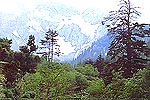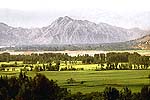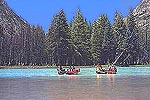From the Second Century B.C Until the Ninth Century A.D, Buddhism flourished in Swat, and the vale was the birth place of Vajrayana (Tibetan) Buddhism. In the eighth century the historical figure who has come to be known as Guru Rimpoche or Padmasambhava left Swat, or Uddiyana as it was called then, and embarked on his long journey of conversion through Ladakh and Tibet. The Nyingma sect of Buddhism that he taught is still followed in many regions within Ladakh, Tibet and Nepal. Scores of archeological sites in Swat recall its Buddhist era, a period that lasted in a small way untill the sixteenth century.
 Swat was also the historic land where muslim conquerors like Mahmud of Ghazni, Babur and Akbar fought their battles preparatory to the
conquest of the subcontinent. The ruins of great Buddhist stupas, monasteries
and statues are found all over Swat.
Swat was also the historic land where muslim conquerors like Mahmud of Ghazni, Babur and Akbar fought their battles preparatory to the
conquest of the subcontinent. The ruins of great Buddhist stupas, monasteries
and statues are found all over Swat.
The upper valleys of Swat Kohistan, "Swat's Land of Mountains," rise up to steep, pine-covered ridges that lead toward scores of snow-clad 18,000-foot peaks. Swat receives adequate monsoon rain and has an Alpine flavour reminiscent of the Rockies or Alps.
 The headquarters of Swat Valley, Saidu Sharif, houses the Swat Museum which contains one of the finest collections of Gandhara art
in the world. Mingora, 3 kms from Saidu Sahrif, has yielded magnificent
pieces of Buddhist sculpture and the ruins of great stupas. Thirty miles
north of Mingora is the pleasant town of Madyan in the last open stretch
before a pine-clad gorge leads to Swat Kohistan and, in another 30 miles,
to Kalam. In the upper Swat, look for the unique mosques constructed entirely
entirely of wood that are found in most villages. These mosques have a
quiet beauty despite their modest size.
The headquarters of Swat Valley, Saidu Sharif, houses the Swat Museum which contains one of the finest collections of Gandhara art
in the world. Mingora, 3 kms from Saidu Sahrif, has yielded magnificent
pieces of Buddhist sculpture and the ruins of great stupas. Thirty miles
north of Mingora is the pleasant town of Madyan in the last open stretch
before a pine-clad gorge leads to Swat Kohistan and, in another 30 miles,
to Kalam. In the upper Swat, look for the unique mosques constructed entirely
entirely of wood that are found in most villages. These mosques have a
quiet beauty despite their modest size.
 Marghazar, 13 kms from Saidu Sharif is another captivating spot worth visiting which is famous for its "Sufaid Mahal" (White Mahal).
This is the white marble palace of the former Wali (ruler) of Swat. The
town of Bahrain is another popular riverside resort, situated about 66
km from Saidu Sharif, only 10 km from Madyan. The Ushu (2,286 meters),
Utrot (2,225 meters) and Gabrial (2,286 meters) valleys, north and west
of Kalam respectively, are the best trekking areas in Swat (take a local
guide along for safety purposes). These valleys are considered to be the
best trout fishing zones of Swat and the sorrounding thick pine forests
are excellent for hiking. The 6,257 meters high snow capped 'Falaksair
Peak' is clearly visible from Matiltan (3,000 meters). Some 23 km beyond
the Matiltan valley is 'Lake Mahodand'. This lake is as beautiful as the
famous lake Saif-ul-Muluk in the Kaghan valley.
Marghazar, 13 kms from Saidu Sharif is another captivating spot worth visiting which is famous for its "Sufaid Mahal" (White Mahal).
This is the white marble palace of the former Wali (ruler) of Swat. The
town of Bahrain is another popular riverside resort, situated about 66
km from Saidu Sharif, only 10 km from Madyan. The Ushu (2,286 meters),
Utrot (2,225 meters) and Gabrial (2,286 meters) valleys, north and west
of Kalam respectively, are the best trekking areas in Swat (take a local
guide along for safety purposes). These valleys are considered to be the
best trout fishing zones of Swat and the sorrounding thick pine forests
are excellent for hiking. The 6,257 meters high snow capped 'Falaksair
Peak' is clearly visible from Matiltan (3,000 meters). Some 23 km beyond
the Matiltan valley is 'Lake Mahodand'. This lake is as beautiful as the
famous lake Saif-ul-Muluk in the Kaghan valley.


